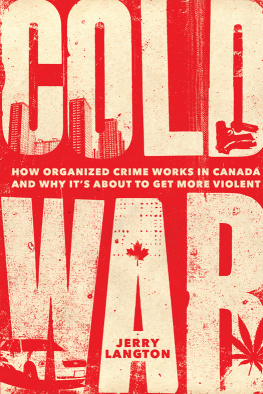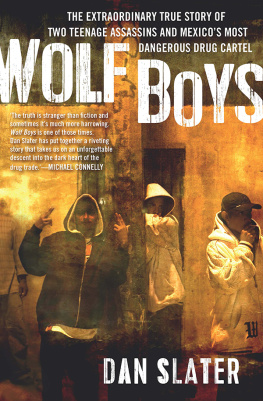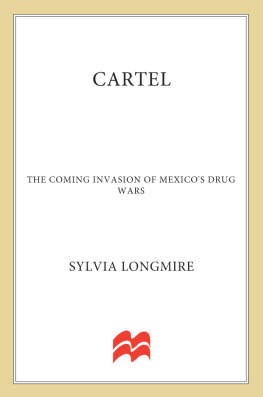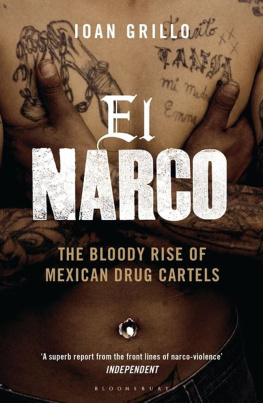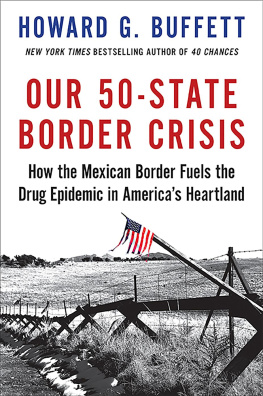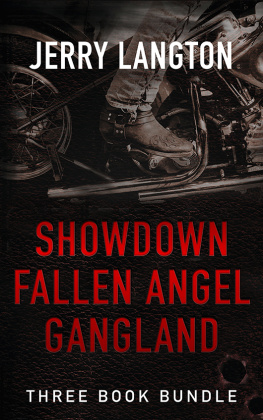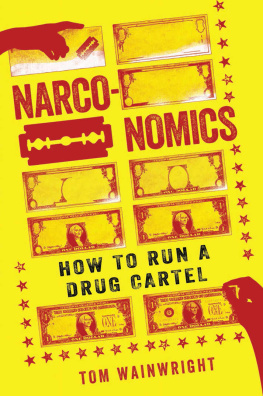Gangland
The Rise of the Mexican Drug Cartels from El Paso to Vancouver
Jerry Langton

To the Langton-Cowan Organization:
La Salchicha, El Dida
and El Hoohoo.
Acknowledgments
In addition to the many brave people mentioned in my sources, I would also like to thank the team at John Wiley & Sons for their support and enthusiasm: editor Don Loney, marketer Robin-Dutta Roy, production editor Elizabeth McCurdy, publicist Erika Zupko, and national account manager for Indigo and Online, Paul Coulombe. Special thanks to Michael Nicholson, whose enthusiasm and encouragement were vital to this project and to Brian Rogers. Thanks also to Leta Potter, who wields considerable clout in all things. And, of course, I must thank my wife and kids for their infinite patience, good humor and creativity.
Chapter 1
Deadly Playground
It wasn't always this way. Just a few years ago, El Paso and Jurez were like one big city, the border more a formality than anything else to most people. You'd go to Jurez for a good time; we'd go pretty much every weekend, said Tim McNeill, an El Paso resident who hasn't been across the border in five years. It was fun; you could drink and have a good time, buy things that weren't allowed over here ... it was where you went to blow off steam. El Paso was the nice, but straight-laced neighborhood, and Jurez was the poorer, more religious, maybe a little more dangerous cousin where residents from either side of the border could let their hair down and enjoy themselves.
But times changed. Economic challenges have deeply impoverished the Mexican side, especially compared to their neighbors just a few yards to the north. Mexicans have long been poorer than Texans, but failures in the economy at the end of the 20th century made the distinction even sharper. That economic hardship has sent literally millions of Mexicans north, looking for better lives. Because the United States is a very difficult country for foreigners to live and work in legally, most of the Mexicans who have moved there are undocumentedwhat are referred to for the purposes of this book as illegal immigrants. Unprotected by many of the laws U.S. citizens and legal immigrants take for granted, illegal immigrants lead a shadow life, aware at any moment they can be deported back to Mexico. Many of these people feel betrayed by the Mexican government and ignored by the American government.
Other factors have changed the landscape. Drugs, both legal and illegal, have long been a reason for Americans to cross over into Jurez. You can buy many popular prescription drugs (Viagra is a favorite) over the counter without a prescription in most of Mexico, which has long been drawing Americans and American dollars over the border. And although the laws on recreational drugs like marijuana had largely been the same in Texas and Mexico until recently, they have long been much more tolerated in Jurez, where the police rarely ever got in anyone's way. Not surprisingly, Jurez and other border cities have become funnels for drugs being shipped into the U.S.
It is a situation both countries basically tolerated, if not officially approved. The drug tradewhich was illegal, but largely peacefulflourished in Jurez and other border cities for decades. Then Richard Nixon declared a War on Drugs in 1972, working to intercept drugs coming into the country. Using sophisticated detection methods and applying harsh penalties, the Americans drove the drug trade farther underground. The increase in danger led to an increase in rewards as drug users paid higher prices for smaller quantities. The new rewards attracted organized crime, and the tougher border led them to employ illegal immigrants. A new equilibrium was established as drug traffickers got rich and the drug trade became a much bigger part of the economy. Narcocorridas danceable songs celebrating the exploits of drug traffickersbecame popular. Kids started emulating the drug runners and their gangster bosses.
Then it changed again. When the Mexican government cracked down on the drug cartelsthe crime organizations that had evolved from street gangs acting as mules, ferrying product between drug lords in Colombia and retailers in the U.S. and Canadain 2006, they fought back. In the few years since, thousands of people have been killed, much of Mexico is considered too dangerous for North Americans to enter and the nation itself is said by experts (including the U.S. State Department) of being in danger of absolute collapse.
In the old days, there were signs everywhere hawking products to North Americans the moment you entered Jurez. And as soon as you crossed the border, a taxista would offer you a ride or a hawker would appear hoping to sell somethingoranges, prescription drugs, or maybe just a free ticket to the kind of strip show you'd never see north of the Rio Grande. That's all gone now. The signs are almost all graffiti now, some hailing Che Guevara and other champions of anti-imperialism, others exhorting the locals in Spanish to go to church and read their bibles. Nobody approaches the visitors from the north anymore. Instead, the first thing you see is the military, soldiers wearing masks so the cartels can't identify them and threaten their families. They're everywhere in Jurez, doing their best to keep the peace.
Two blocks south of the bridge over the Rio Grandeat the corner of Jurez and Azucenasyou can see vestiges of what Jurez used to be like. On one corner is a massive, windowless bar called Tequila Derby, across from it the Centro Juarez Liquor Center and on the other side is the Juarez Race & Sports Book, a gambling franchise. Next to it is Drug Discount Pharmacywith the slogan The Best Price in Townoffering all kinds of medicines over the counter. Many of the other shops, like discount opticians and dentists, are also clearly aimed at Americans. All the signs are in English, with prices given in dollars as well as pesos. Many of the shops are now shuttered and there's little traffic, either walking or driving. There are a few juice and shaved-ice vendors, but everywhere you look there are collections of men, mostly young, just hanging around, apparently with nothing better to do. On almost every pole, there is a sign taped up, appealing for information about a missing woman.
On the next block there is a collection of bars catering to American customers. From the outside, the Kentucky Club doesn't look like much. It's just a one-level storefront between a fancy restaurant and a pharmacy selling Viagra and Cialis by the pill. The building is painted light green and it has a dark green awning to shade the front windows from the desert sun. On the awning there is orange and yellow art deco script reading World Famous Kentucky Club Since 1920. Above that is an old red, white and blue sign sponsored by Tecate, a popular beer brewed in another Mexican border city.
Its exterior plainness belies its rich history. The bar claims that it is the birthplace of the margarita, although that's been widely disputed. In its heyday during the 1950s and '60s, it was incredibly popular with famous Americans: Ronald Reagan is said to have enjoyed drinking there, as did John Wayne. Richard Burton and Elizabeth Taylor were semi-regulars there, and both Jim Morrison and Bob Dylan dropped by the Kentucky Club when they were searching for some lyrical inspiration. Most famously, Marilyn Monroe bought a round of drinks for the whole bar to celebrate her divorce from Arthur Miller.


